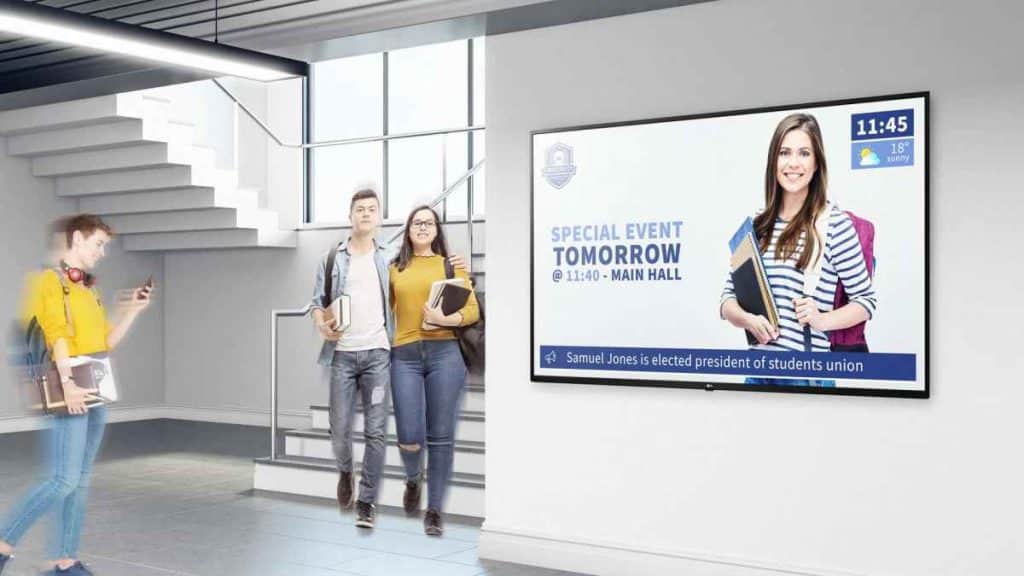In today’s fast-paced world, effective communication and event promotion is vital for educational institutions to engage their students, faculty, and staff. Traditional methods, such as physical posters and flyers, have limitations in reach and visibility, resulting in reduced event attendance and engagement. However, the emergence of digital signage has revolutionized event promotion in educational settings, offering numerous advantages over conventional approaches.
This article explores how digital signage transforms event promotion in educational institutions, enhancing communication and engagement.
Traditional Event Promotion Challenges in Educational Institutions
Educational institutions face several challenges when it comes to promoting events using traditional methods. Physical posters and flyers have limited reach, often restricted to specific notice boards or common areas. Additionally, these materials are easily overlooked in the bustling environment of schools, colleges, and universities. Moreover, the time-consuming process of printing and distributing posters can delay event promotion, miss opportunities to create enthusiasm, and boost attendance.
Updating event information in real-time can also be challenging with traditional methods. Changes in schedules, venues, or event details may not reach the target audience promptly, leading to confusion and potential disruptions during the event. These challenges highlight the need for a more efficient and effective event promotion solution.
Advantages of Digital Signage over Traditional Methods
- Enhanced Visibility and Attention-Grabbing Capabilities: Digital signage stands out in crowded environments due to its vibrant displays and dynamic content. Eye-catching animations, videos, and scrolling announcements capture the attention of passersby, increasing event awareness and participation.
- Real-Time Updates and Dynamic Content: One of the most significant advantages of digital signage is the ability to update content in real time. Event organizers can easily make changes to event details and schedules, with the updates immediately displayed on the screens. This ensures that the target audience receives the latest information, reducing the chances of confusion.
- Customization and Personalization for Different Events: Digital signage allows for easy customization of content for different events, making it a versatile communication tool. Whether it’s a sports tournament, academic conference, or cultural performance, organizers can tailor the content to suit the specific event and its audience.
- Reduced Environmental Impact: By eliminating the need for physical posters and flyers, digital signage promotes a more sustainable approach to event promotion. Educational institutions can reduce paper waste and contribute to their environmental responsibility through the adoption of digital signage solutions.
How Digital Signage Transforms Event Promotion
Digital signage has a transformative impact on event promotion within educational institutions, benefiting various aspects of communication and engagement.
- Improved Event Visibility and Attendance: Digital signage significantly enhances the visibility of upcoming events. Strategically placed screens in high-traffic areas, such as entrance halls, cafeterias, and libraries, ensure that students, faculty, and staff are constantly exposed to event promotions. The increased visibility leads to higher event attendance and participation, creating a vibrant campus community.
- Increased Student and Staff Engagement: Engaging multimedia elements, such as videos and interactive displays, encourage active involvement and interactivity. This heightened engagement helps build a sense of community and encourages a stronger connection with the institution.
- Streamlined Event Management and Organization: With real-time updates, event organizers can swiftly communicate any changes or announcements related to the event. This streamlines the logistics and reduces the potential for confusion among attendees. Additionally, digital signage can be integrated with event management software, enabling automated scheduling and content distribution.
Implementing Digital Signage in Educational Institutions
Implementing digital signage in educational institutions requires careful planning and consideration. The following steps can guide institutions in adopting this transformative communication tool effectively:
- Assessing the Institution’s Needs and Objectives: It is essential to identify the specific communication needs and event promotion goals of the institution. Understanding the target audience, event types, and desired outcomes helps determine the scope and scale of the digital signage deployment.
- Selecting the Right Digital Signage Solution: Institutions should evaluate different digital signage solutions based on their hardware capabilities and software features. Factors such as screen quality, compatibility with content management systems, and ease of use should be considered during the selection process.
- Budgeting and Cost Analysis: Digital signage implementation involves upfront costs for hardware, software licenses, installation, and maintenance. Institutions should carefully assess their budgetary constraints and conduct a cost-benefit analysis to determine the return on investment (ROI) of adopting digital signage.
- Installation and Maintenance Best Practices: Proper installation and maintenance of digital signage systems are crucial for their optimal functionality. Factors such as screen placement, network connectivity, and regular content updates should be considered to ensure a seamless user experience.
Content Creation and Management for Digital Signage
To maximize the effectiveness of digital signage in event promotion, institutions should focus on creating compelling and informative content:
- Design Principles for Effective Event Promotion: Content should be visually appealing, incorporating attractive colors, typography, and graphics. Clear and concise messaging, coupled with attention-grabbing visuals, helps convey event information effectively.
- Creating Visually Appealing and Informative Content: Multimedia elements, such as videos, images, and animations, can be utilized to make the content more engaging. High-quality visuals, combined with concise event details, generate interest and encourage attendance.
- Utilizing Multimedia Elements: Videos and animations can provide glimpses of past events, showcase performances, or share testimonials from previous participants. Images can highlight event locations, speakers, or performers, creating anticipation and excitement.
- Content Scheduling and Management Systems: Institutions should establish a content management system to efficiently schedule and update event promotions on digital signage. This ensures that the right content is displayed at the right time, maximizing the impact of event promotion.
Conclusion
Digital signage has revolutionized event promotion in educational institutions, overcoming the limitations of traditional methods. By enhancing event visibility, increasing engagement, and streamlining event management, digital signage transforms the communication landscape within educational settings.
Educational institutions should embrace this technology, leveraging its power to enhance communication, foster engagement, and create memorable event experiences. Through the adoption of digital signage, educational institutions can revolutionize event promotion and elevate their overall communication strategies.
